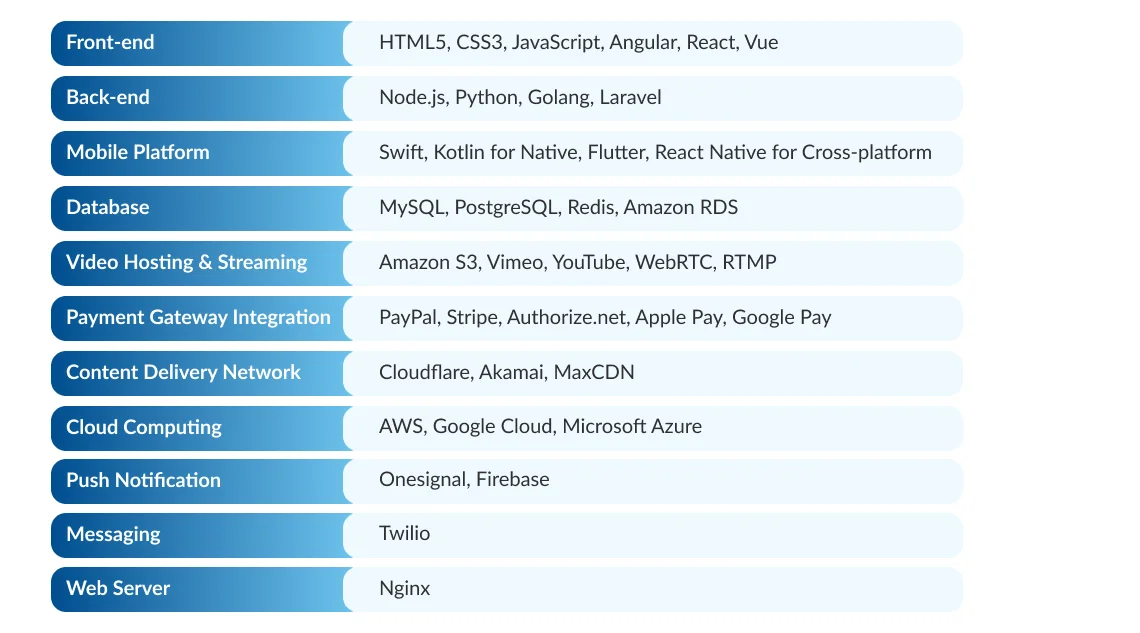How To Build An eLearning Platform Like Coursera?
- Mobile
- December 6, 2023
If you are wondering how to create an eLearning platform like Coursera or Udemy, this blog post will serve as a detailed step-by-step guide. It highlights the steps to build an eLearning platform like Coursera, essential features, current market leaders, and more.
In recent times, there has been a surge in demand for online education, the pandemic being the catalyst for it. This trend is continuing to grow, and the revenue projections attest to it. According to a global market insight by Statista, the Online Education market volume is projected to reach US$279.34bn by 2029. With user penetration expected to hit 11.6% by 2027(which was 9.6% in 2023), the global e-learning market is forecast to reach almost 400 billion U.S. dollars by 2026.
These statistics represent developing an EdTech like Coursera, a lucrative revenue generation opportunity. The startup visionaries can monetize EdTech through various models such as subscription plans, course sales, certifications, and more. Additionally, partnerships with educational institutions and content creators can create additional revenue streams.
As more individuals and organizations seek accessible and high-quality learning solutions, an eLearning platform presents entrepreneurs with a scalable and financially rewarding venture.
Before learning how to develop an eLearning platform like Coursera or Udemy, let us first get an idea of the market leaders.
Top Massive Open Online Course (MOOC) Platforms
MOOCs are online courses designed to accommodate a large number of participants(anyone around the globe with internet access). The MOOC market is a dynamic and rapidly evolving online education sector. In order to navigate this landscape effectively, it’s crucial to be aware of or identify the leading players who have carved out a substantial presence in the MOOC market.
Apart from Coursera, here are some of the top MOOC platforms or websites like Coursera that are shaping the industry’s future:
- edX
- Udemy
- FutureLearn
- Khan Academy
- Udacity
By understanding their contributions and innovations, you’ll gain valuable insights into the trends and developments driving online education on a massive scale.
When aspiring to create an eLearning platform like Coursera, understanding the essential features is paramount. These features are the building blocks that enable the dedicated mobile app developer for hire to build MOOC platforms that offer seamless, engaging, and effective online learning experiences. Let’s explore the must-have features that will set your eLearning platform on a path to success of your MOOCs platform.
Must-Have Features To Build eLearning Platform Like Coursera
Having the right features can make all the difference! Here are some essential features that every website like Udemy or Coursera should have catering to administrators, students, and teachers alike.
Admin Panel
User management: Empowers platform administrators to efficiently oversee and manage user accounts, ensuring a smooth and secure eLearning experience for all.
Dashboard: An all-inclusive screen to manage and monitor all aspects (user activities, course progress, and overall platform performance) of the eLearning platform.
Manage notifications: This feature enables the admins to control and customize notifications (sharing updates on new features or sending reminders for tests and assignments) to keep the users better informed.
Subscription plan management: Seamless management of subscription plans (oversee and control subscription plans), ensuring flexible and effective learning options for users.
Payment management: A feature that enables administrators to handle financial transactions, track revenue, manage course fees, and more.
Content Management System(CMS): Administrators require CMS to effortlessly manage and update course content, easily upload, update, and organize courses, lectures, multimedia content, and user access, streamlining content delivery and management.
Offers and discounts management: With this feature, the admins can create and manage special promotions, enhancing the affordability and appeal of courses on the eLearning platform.
Commission module: Enables management and tracking of commissions earned by instructors and partners, ensuring fair compensation to foster a fair and transparent revenue-sharing system.
Statistics reports and performance tracking: Enables better monitoring and assessment of learner’s progress and course effectiveness apart from the platform’s performance through data-driven reports and analytics.
User support: The administration can offer efficient management of user inquiries, and feedback, along with assisting learners with technical issues, and guidance.
Student Panel
Dashboard: A centralized hub where students can track their progress, access courses, view assignments, access resources, monitor achievements, and stay organized.
Search, category, and filter: This feature enhances user-friendliness by offering learners easy user navigation to explore, organize, and find courses with search options, categorized content, and smart filtering tools.
Course enrollment: The student can easily browse, select, and enroll in courses of their choice with this user-friendly enrollment process feature.
Recommendations: This essential feature provides learners with personalized course suggestions based on a student’s learning history and preferences to guide them toward relevant and engaging content.
Reviews/Feedback: With this feature, the students can provide valuable reviews and feedback on courses, instructors, and overall learning experiences, ensuring the platform maintains high-quality education standards.
Push notifications: Keep students engaged and informed with instant alerts and updates on their courses, assignments, and important announcements.
Video player and streaming: This feature empowers students to access and engage with video content seamlessly along with access to course content through high-quality live lectures, offering students interactive and dynamic learning experiences.
Collaboration and communication tools: This enables the students to connect, interact, and collaborate seamlessly with peers and instructors through chat, discussion forums, video conferencing, and collaborative document editing.
Certification management: With this feature, the students can easily access, track, and manage their course certifications.
Easy payment options: Simplify the payment process for students with this feature to offer them convenient payment methods.
Teachers Panel
Dashboard: A comprehensive interface for teachers to get real-time insights, manage courses, track student progress, course management tools, and access vital teaching tools.
Course creation and updates: This feature offers the educators ability to create new courses and update existing ones, ensuring the content is up-to-date and relevant.
In-built chat: Enhance real-time interaction and support between educators and students with a built-in chat feature.
Push notifications: With this feature, educators can provide students instant alerts, keeping them updated on course announcements, deadlines, and important events, ensuring timely updates.
Pricing management: It allows the teachers to set and adjust course fees.
Steps To Building A eLearning Platform Like Coursera
The development process involves several essential steps that will pave the way for your e-learning platform’s success. This comprehensive guide for aspiring entrepreneurs will walk you through the essential steps, breaking down the process into simple, ensuring you’re well-prepared to bring your vision of building an eLearning website into reality.
Read further to explore the key stages of building a website like Coursera.
1. Understanding the market
Before beginning with the development of your MOOC platform like Coursera, it is necessary to gain a foundational understanding of the online education market to ensure that your eLearning website is well-positioned for success in a competitive online education landscape.
Apart from it being the vital cornerstone of your project’s success, it is an essential phase that sets a solid foundation, ensuring that your eLearning platform caters precisely to the needs and preferences of your future users. Here are some of the essential considerations to make when conducting market research and defining goals:
- Assess target audience
- Research potential users’ needs and preferences
- Know current market demands
- Competitive intelligence
- Trends and innovations
- Determine features/functionalities
- Identify the gaps
- Define unique selling points (USPs)
- Analyze types of courses and content
- Determine the scalability and growth potential
- Align your platform’s vision with market demands
Once you have an overall idea of the current status of the market and how you can contribute to this market with your eLearning solution, the next step is to partner with an expert Edtech development company.
2. Choose your EdTech app development company
Unlike bringing together an in-house team, choosing to outsource the development of your EdTech app is more cost-effective and offers various benefits like faster time to market, specialized team, quality of development, and better utilization of budget and available resources.
Here are some criteria you can consider when choosing an eLearning platform development company:
- Industry experience
- Portfolio and case studies
- Cost and budget alignment
- Maintenance and support services
- Client references and reviews
- Customization options
- Timely project delivery
- Clear communication and collaboration processes.
Also Read: How to Choose the Right Mobile App Development Partner.
3. Design UI/UX of your EdTech
User centricity and aesthetics go hand in hand when it comes to delivering an engaging user experience to the target audience. A well-thought-out UX/UI design would play a pivotal role in offering the user-friendliness when interacting with your eLearning platform encouraging engagement and retention.
For designing an effective app UI/UX design ensures easy navigation in your MOOC platform, accessibility to users with disabilities, incorporation of the latest design trends, seamless experience across various screen sizes, and more.
Along with it, take factors like the brand’s identity, layout, color schemes, typography, navigation menus, and other interactive elements into consideration to create a visually appealing and user-centric eLearning platform like Coursera or Udemy.
4. Define the tech stack for your eLearning app
It is the choice of tech stack that would affect how your site functions, its performance, scalability, security, user experience, and more. This is why it is essential to assess the project’s specific requirements and goals before beginning the development process. Here is an ideal tech stack for developing websites like Coursera or Udemy.

Once your development team has defined the tech stack, it is time to kick off the development process.
5. Develop your eLearning platform
When bringing EdTech ideas to life, startup founders or entrepreneurs don’t want to believe that they could be wrong with their ideas. Well, being optimistic is good, but after developing a full-scale product, ending up realizing it is not what your target audience wants would only burn a hole in the pocket and eventually result in cash burn. So, it involves developing a minimum viable product(MVP) first.
It’s like laying the foundation(with basic features and functionalities) and then making incremental improvements over time based on your target audience’s feedback.
Before diving into MVP development, a pivotal decision is whether to opt for a white-label EdTech solution or go with custom development.
Pre-made EdTech Solutions
With a pre-made solution, you can build eLearning websites like Coursera with free plugins and open-source platforms like Moodle, Joomla, or Canvas.
Though off-the-shelf or white-label solutions offer cost-effectiveness (not much in the long term) and quicker time to market, they tend to have various constraints like limited/basic features, compatibility issues, scalability/flexibility limitations, and not to forget the cookie-cutter user experience. When opting for a website builder, you have to share the platform’s data ownership, raising some data security and privacy concerns.
In a nutshell, ready-made MOOC platforms struggle to stand out amongst competitors.
Custom eLearning App Development
With EdTech Unicorns competing fiercely to stay on top, offering generic AI-powered eLearning solutions that would attract target users(with 64% of them accessing courses on their mobile) can be challenging. The off-the-shelf(basic) features would not be enough to make your eLearning platform stand out from the existing ones. Though custom EdTech development can be a long haul, it is inevitable(rather highly recommended) for your EdTech business success.
Unlike the pre-made solutions, tailored eLearning website development offers business visionaries the benefit of extended flexibility, boundless scalability, infinite integrations, complete data ownership, fine-tuned user experience, and comparatively lesser development cost in the long term.
6. Testing and deployment
The testing does not end with just finding the error in the code, the QA engineer has to ensure that all the features and functionalities are working smoothly. Further, it is essential to ensure that EdTech offers a smooth and streamlined user experience apart from smooth functioning across devices, browsers, and scenarios.
Once the eLearning platform is rigorously tested and all the identified bugs and glitches are resolved, it’s time to initiate the deployment. From web hosting to configuration, security measures, monitoring, and scalability, make sure that the mobile app developer you hire ensures that everything is running smoothly.
7. Post-deployment maintenance and support
It does not end with development as it is indispensable for a startup founder to ensure that their EdTech is delivering the desired performance, is relevant and all the security measures in place are serving their purpose after deployment.
Various post-deployment maintenance activities include performance optimization, security/content updates, user experience enhancement, scalability, legal compliance, and more so that your MOOC platform like Udemy stays secure, bug-free, and up-to-date.
Must Read: The Ultimate Guide to Develop a Language Learning App
Build Your Own eLearning Platform Like Coursera With MindInventory!
MindInventory is a leading digital transformation company with a knack for custom EdTech development enabling you to overcome specific challenges and to deliver custom features and functionalities in your eLearning platform or learning management system.
With our proficiency in designing cutting-edge education apps and ability to craft custom eLearning platforms featuring cutting-edge interfaces and trending technology stacks, we stand out as your ideal development partner.
Whether you’re targeting students from kindergarten to higher education, MindInventory has the expertise to deliver top-notch Edtech solutions for all grade levels. Our team of veteran designers & developers has extensive experience in building feature-rich education apps and websites ensuring that we can create a custom Edtech solution tailored to your unique needs, helping your EdTech shine in today’s competitive market.

FAQ on eLearning Platform
The cost of building an eLearning platform like Coursera or Udemy varies from $40,000 to $300,000, depending on the features and complexity. Other factors that influence the cost of developing a Coursera-like platform include the technology stack, third-party integrations, development team size and location, developer experience, hiring engagement model, and more.
The tech stack of Coursera includes technologies like JavaScript, JQuery, Node.JS, React, MySQL, Bootstrap, Django, GraphQL, Scala, and more.
Some of the different types of eLearning platforms are video-based learning, learning management systems, massive open online courses(MOOCs), custom eLearning platforms, virtual learning environments (VLE), One-on-One online learning, eLearning platforms for teachers, online employee training platforms, online consulting and more.
Building sites similar to Coursera involves complying with several important compliance requirements. These include adhering to copyright rules, especially when using third-party content. Ensuring GDPR and COPPA compliance is crucial to protect user data and privacy apart from implementing user privacy and consent procedures is also essential. To meet these standards effectively, it’s essential to seek guidance from legal and compliance specialists who can ensure that your platform operates within the boundaries of these regulations.













